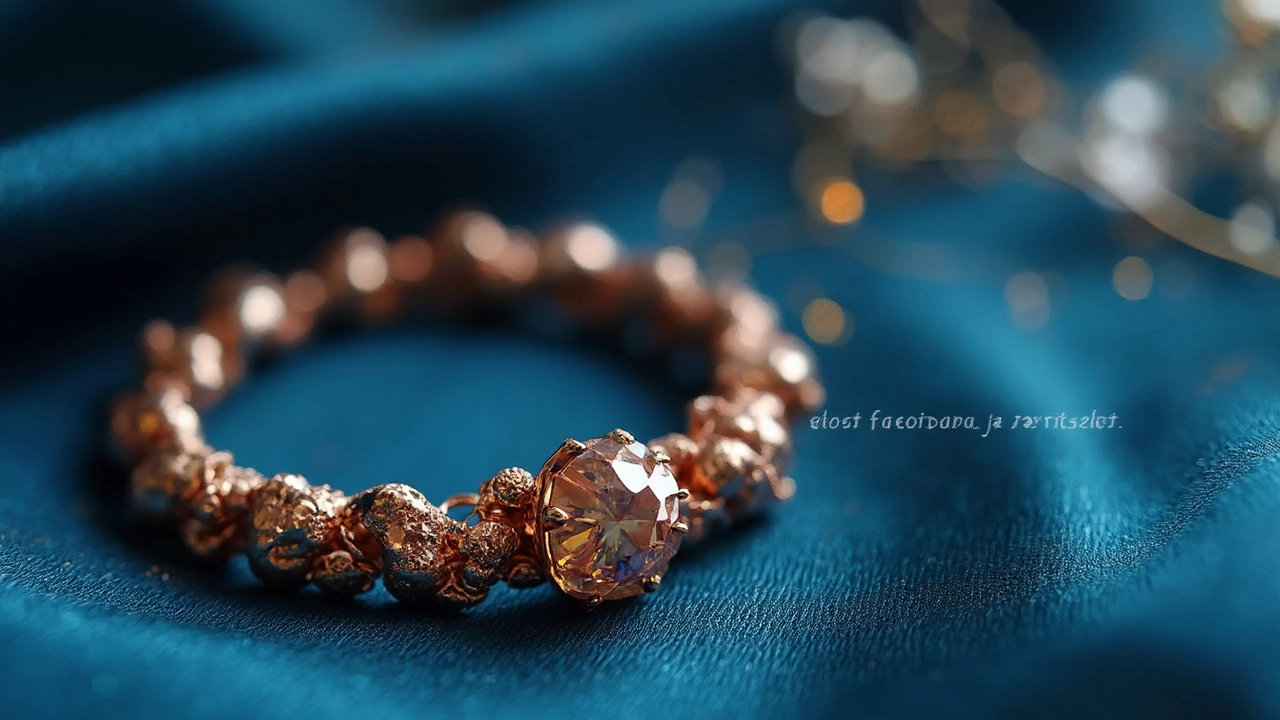
So, you're thinking about adding a touch of rose gold to your jewelry collection? Before you dive in, there are a few things you might want to know to make sure it's the right choice for you. Rose gold, with that charming pinkish hue, gets its color from a mix of gold and copper. While this blend gives it that romantic vibe, it does come with its own set of quirks.
First off, let's talk about how durable it is. It's no secret that rose gold can be less durable than yellow or white gold. Thanks to the copper content, it's a bit more prone to scratches and dents. If you're planning to wear it every day, think about how much wear and tear it might get.
- Understanding Rose Gold Composition
- Durability Concerns
- Allergic Reactions
- Color Change Over Time
- Maintenance and Care
- Alternative Options
Understanding Rose Gold Composition
Alright, let's break down what makes up rose gold. This unique jewelry option finds its charm in its color, which is the result of mixing pure gold with copper. Typically, it contains about 75% gold and around 22.25% copper, with a sprinkle of silver, around 2.75%, to balance things out. The higher the copper content, the more pronounced the rosy tone becomes, giving it that eye-catching look.
One thing to keep in mind is that rose gold isn't a naturally occurring metal like yellow gold. It's an alloy, which means it's a combination of different metals. This makeup not only influences its color but also affects its properties—like how malleable or durable it is, which we'll get into in just a bit.
The Role of Copper
The presence of copper is key in giving rose gold its signature blush. However, copper isn't just there for the looks; it's also what makes rose gold a bit stronger than yellow gold. But be warned, this also means it might not be as hypoallergenic as some other metals out there.
The Color Factor
Interestingly, the color of rose gold can vary depending on the copper content. Some pieces might appear a bit more red, while others lean towards pink. This gives you some room for personalization when picking out your jewelry.
If you're ever curious about the specific makeup of a rose gold piece, you can usually find this information in what's called a hallmark. This mark indicates the purity of the gold in the jewelry, so you'll know exactly what you're working with.
Durability Concerns
When choosing jewelry, durability is a big deal, especially if you're into rose gold. So, what's the scoop? Well, rose gold might look stunning, but it's not the toughest kid on the block. The unique rose gold shade comes from blending gold with copper, which is softer than some other metals used in jewelry.
Why Copper Matters
The addition of copper gives rose gold its lovely pink tint, but it also means it's not as hardy as yellow or white gold. This matters because everyday wear and tear can quickly take its toll. Imagine snagging a ring on your bag or accidentally bumping a bracelet against a countertop—these little things add up.
Softness and Scratches
Because of its composition, rose gold is more susceptible to scratches and dings. If you’re the kind of person who wears jewelry all the time, think about how easily rose gold can get marked up.
Maintenance Woes
Let's not forget maintenance. All that wear and tear means rose gold pieces might need more frequent polishing or even re-coating to keep that lovely sheen. Caring for rose gold requires a gentle touch and sometimes a bit more effort than you might expect.
So, while rose gold might shine brightly in your jewelry box, make sure you're ready to handle the extra care it brings. If you're set on rose gold, just be mindful of where and when you wear it to keep it looking its best.
Allergic Reactions
Wearing jewelry should add joy to your life, not discomfort. Unfortunately, for some people, rose gold isn't the most skin-friendly option. The key culprit here is copper, which, when alloyed with gold, creates that lovely pink shade but can sometimes trigger allergies.
Most folks who've had reactions to jewelry know the drill: a bit of itching, redness, or maybe even a rash. It's not the gold causing the problem; it's typically the copper element. If you're someone who already knows you've had issues with copper in the past, it might be wise to test rose gold jewelry on a small patch of skin before committing to anything too pricy.
What Causes the Reaction?
The higher the copper content, the more likely a reaction might occur. This isn't exclusive to rose gold; any piece with a significant copper mix runs this risk. The body's natural chemistry can also play a part, meaning some people might wear copper-containing jewelry without a hitch, while others won't be so lucky.
How to Minimize Risks
- Consider applying a clear coat of nail polish on the inside of rings or bracelets. It acts as a barrier between your skin and the metal.
- Opt for gold jewelry with a lower copper content. The more gold in your rose gold piece, generally, the less copper, although this might affect the price.
- If you're planning to get a ring, you might want to look at alternatives like yellow or white gold, which don't contain copper and are generally considered safer for those with sensitive skin.
Always remember that a little precaution can save you from a lot of discomfort down the road. Allergic reactions shouldn't scare you away from beautiful jewelry, but being informed helps you make smarter choices.

Color Change Over Time
Believe it or not, rose gold isn't just about the pretty pink hue; it's about chemistry at work. The color change over time is a reality you might face with this jewelry. Since rose gold is a mix of gold and copper, it's more likely to undergo changes when exposed to the elements.
One thing you might notice is that the pink tint could deepen or even take on a darker, sometimes reddish, shade. This happens because the copper interacts with air, moisture, and even your skin's oils, which can cause what's called tarnishing. It's not just hearsay; scientifically, it's known as oxidation of copper.
"Due to its copper content, rose gold can experience tarnishing more visibly compared to other gold alloys," says James Allen, a renowned jeweler with over 20 years in the industry. "Regular care can mitigate these effects, but they're something every rose gold owner should be aware of."
How To Maintain the Color
Want to keep your rose gold looking fresh? Regular cleaning with mild soap and warm water does wonders. Make it a weekly habit to wipe it down with a soft cloth. Some folks even keep a dedicated jewelry cleaning cloth on hand, which is great for a quick shine.
- Avoid harsh chemicals; they can accelerate the tarnishing process.
- Store your rose gold pieces separately to avoid scratches and minimize any chemical interaction.
- Consider professional cleaning once a year to keep that fresh look.
It's really all about staying ahead. If you love that pink glow, a little extra effort can go a long way. And remember, every piece of jewelry tells a story; the care you take adds to yours.
Maintenance and Care
So, you've decided to go with rose gold for its unique charm. But like all good things, it requires a bit of attention to keep it looking fresh. Here's how you can care for your rose gold jewelry to ensure it lasts as long as possible.
Regular Cleaning
Just like any other gold, rose gold benefits from regular cleaning. You don't need anything fancy here. A mix of warm water and a small amount of mild soap does the trick. Gently scrub with a soft toothbrush, rinse thoroughly, and pat dry with a soft cloth. This keeps the jewelry free of dirt and oils that can dull its shine.
Avoid Chemicals
Harsh chemicals can be the enemy of rose gold. So, it's a good idea to take off your jewelry when using cleaning solutions or even when swimming in chlorinated pools. These can lead to discoloration or tarnishing over time.
Proper Storage
Storing your rose gold jewelry properly is key to maintaining its beauty. Keep each piece in a soft, cloth-lined box to prevent scratches and minimize exposure to air. This is especially important for pieces that you don't wear regularly.
Regular Checks
Due to the copper content, rose gold can change its color slightly over time. Conduct regular checks yourself, and maybe get a professional to take a look every year or so. They can polish out scratches and bring back that lovely, warm glow.
Handling with Care
Lastly, handle your jewelry with care. It might sound obvious, but don't wear them while doing heavy lifting or any activity that can scratch or dent them. A little caution goes a long way in maintaining them.
Following these steps can help keep your rose gold looking as good as new for a long time to come. Remember, a bit of regular maintenance will save you from big repairs down the road.
Alternative Options
Alright, maybe rose gold isn't quite what you're after, or you have concerns about its durability. No worries! There are plenty of other striking choices out there that can offer both style and strength. Let's check out some alternatives that might fit the bill a little better.
Yellow Gold
The classic choice that's been around forever, yellow gold is known for its timeless appeal. It's made using pure gold mixed with metals like copper and zinc, providing a warm, rich color. It's actually less prone to tarnishing compared to its colored counterparts, which makes it an excellent option for daily wear.
White Gold
Palladium
If durability is top of the list, consider palladium. This rare metal is similar to platinum but generally more affordable and lighter. It doesn't tarnish easily, and its natural color means you won't have to worry about re-plating. Perfect for those who want something not too mainstream but still classy.
Platinum
Another great pick is platinum – it's heavier, denser, and yes, on the pricey side. Platinum retains its color and shine, making it a 'what you see is what you get' kind of deal. This one's particularly sought after for engagement rings due to its alluring finish and serious staying power.
Choosing the right jewelry material is all about finding a balance of aesthetic appeal and practicality. Whether you lean towards the classic styles or you're adventurous with modern metals, there's a gold option that will speak to you. Remember, it's not just about following trends but picking something that feels right for you.


